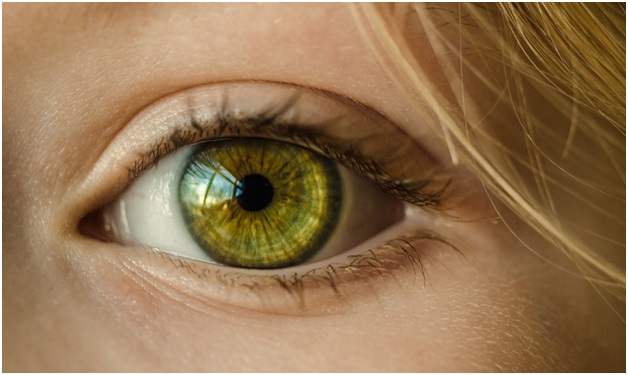
Screens and Digital Eye Strain

You likely use screens in every aspect of your life, from work to relaxation to catching up with friends and family. However, increased screen usage come with an increased risk of digital eye strain.
Digital eye strain occurs for many reasons, one of which is that screen usage affects how often we blink. The average person blinks 15 times a minute, but when we use screens, we tend to blink only half as much and causes our eyes to get dry and irritated. This, in turn, can cause blurry vision or dry eyes.
Screens can also harm our eyes in other ways. Poorly contrasted text and backgrounds, glare, and flickering displays are all hard on our eyes, as is the increased amount of blue light we are exposed to by our screens.
Computer Vision Syndrome
Digital eye strain is also part of a more significant problem which many optometrists refer to as Computer Vision Syndrome or CVS. According to the American Optometric Association (AOA), the most frequent health-related complaints amongst workers who use computers are vision related. Some studies even indicate that between 50% and 90% of computer users suffer from at least some of the symptoms of CVS, which can include eye strain, dry eyes, irritated eyes, blurry vision, and double vision.
Digital eye strain and CVS affect more than our eyes; they can also impact our productivity. A study conducted by the University of Alabama at Birmingham’s School of Optometry found that there was a direct correlation between productivity and proper vision correction. Complex and repetitive tasks such as data entry were particularly affected, and Individuals whose vision suffered were, on average, 20% less productive than individuals whose vision was fine.
Preventing digital eye strain and CVS doesn’t mean you have to give up your phone, tablet, or computer, but it does mean you might want to consider making some changes to your devices and how you use them. Here are ten eye care tips that will help you keep your eyes happy and healthy.
Ten Essential Eye Care Tips
Practice the 20/20/20 Rule
Every 20 minutes take a break and pick an object approximately 20 feet away. Stare at it for 20 seconds. This exercise helps relieve eye fatigue by giving your eyes a break from close up work and allowing them to relax.
Take a Break
Every two hours you should take a break from your screen for at least 15 minutes. Take this time to get up, stretch, and maybe grab a glass of water. This will give your eyes enough time to rest and can reduce the amount of strain you are putting on your eyes.
Invest in Computer Glasses

Computer glasses, or prescription glasses with an Anti Reflective (AR) coating, can reduce the amount of glare your eyes are exposed to by limiting the amount of light reflected off your lens surfaces. This, in turn, reduces the amount of strain computer, and other screen-related work puts on your eyes.
Keep Your Eyes Hydrated
Consider investing in a humidifier in your office, or whichever room you tend to use your digital devices in the most. If your eyes are still feeling dry even with the extra moisture in the air, you may be suffering from Dry Eyes. Dry eyes happen when your eyes are unable to make sufficient tears, or the tears they produce are not high enough quality to keep your eyes lubricated. If you think you may have Dry eyes, you should ask your eye care professional about artificial tears.
Adjust Your Monitor
Your computer monitor should be approximately an arm’s length away from you, and your screen should be about 10 to 15 degrees below eye level. This reduces the amount of strain on your eyes and eye muscles.
Adjust Your Lighting
Excessively bright lights cause eye strain, so when you are using your phone or computer for an extended period of time make sure the ambient lighting in the room is about half as bright as the average office lighting. Lower ambient light helps offset the light coming from your screen.
Reduce glare
You can reduce glare by installing an anti-glare screen on your monitor, and try and work in a room where the walls are painted with matte paint. To reduce the amount of light entering the room either pull the blinds or consider using a computer hood.
Adjust Your Settings
Make sure the brightness on your phone or computer screen is adjusted so that it matches the ambient lighting level in the room. An excellent way to test if your lighting level is adjusted correctly is to open a website with lots of white space. If the white space looks like it is glowing, then your brightness is too high. If it seems to be too dark or looks grey, it is too low.
You should also adjust the size and colour temperature. Make sure text is large enough to read comfortably and adjust your monitor settings so that it emphasizes warmer colours over cooler colours. Blue light, in particular, is hard on our eyes, so reducing the amount of blue light we are exposed to is an easy way to reduce eye strain.
Take a Break From Your Contact Lenses
Contact lenses can dry out your eyes, increasing the amount of strain your eyes experience. If you know you are going to be spending a lot of time looking at a screen, you may want to consider giving your eyes a break by using your glasses. Glasses can also be treated with an Anti-Reflective (AR) coating, while contacts cannot. As we mentioned earlier Anti-Reflective coatings reduce the amount of glare your eyes are exposed to while you use digital devices.
Schedule Regular Eye Exams

Annual eye exams are an essential part of your eye care regime. By scheduling exams regularly for you and your family, your eye care professional can keep an eye out for any potential issues, and address them before they become problems. Early detection is key to mitigating or even avoiding damage to your vision.
Regular eye exams also allow your optometrist to track any changes in your vision and offer corrective solutions if required. Clear, crisp vision is also essential to maintaining a high quality of life.
Conclusion
We rely on our vision for a lot of things, so it is essential to take care of it. By taking steps to reduce digital eye strain and CVS. If your eyes consistently feel dry or strained, or your vision changes in any way you should schedule an appointment with your optometrist as soon as possible.
